Although butterflies, including citrus swallowtails, are particularly prolific in autumn, I was surprised to see a small group of butterflies gathering together while they sucked up moisture on the lawn. Even more surprising – I was able to get some photos of them as they were keen on returning to the same patch as they flitted about.
I have been thinking about doing a post on recent surprising sightings in the garden, but some of the surprises warranted a single post dedicated just to itself, such as the recently seen fabulous beetle that I wrote about here. The same applied to the unusual group of citrus swallowtail (Papilio demodocus) butterflies, as this sighting has developed into a single post about these particularly eye-catching butterflies.

Flitting and flapping as they suck on droplets of the previous night’s rain caught between the blades of grass and also absorbed by the lawn clippings, these citrus swallowtail butterflies made quite a sight as they almost jostle each other as they gather together

The butterflies were so busy in the early morning sunshine that it was quite tricky to photograph them. Perhaps the video below provides a better impression of all the activity as well as the beauty of these lovely butterflies
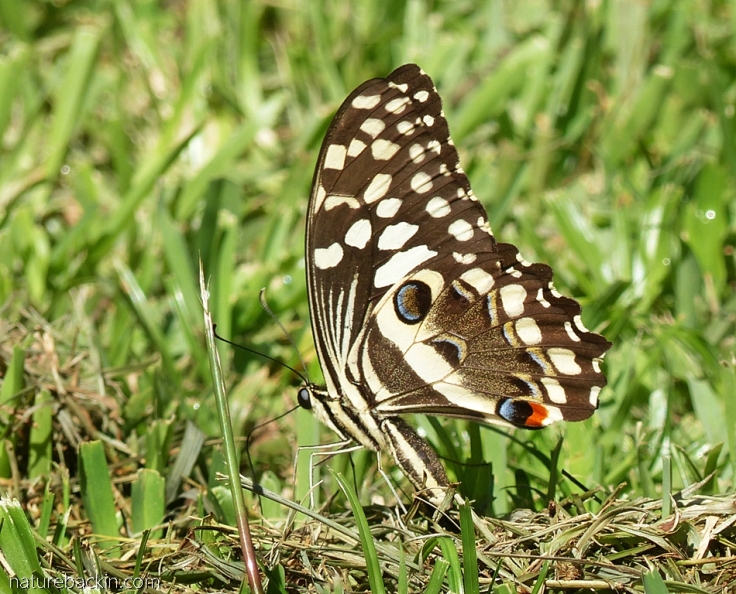
Amongst all the activity I captured a single butterfly in profile, showing its long proboscis extended and curved downwards as it penetrates into the grass clippings to suck the moisture retained in the grass. I wonder if the grass clippings are not fermenting slightly providing additional nutrients to the moisture

Earlier this month on an overcast day, a citrus swallowtail butterfly settled on a brick pathway enabling me to creep up behind it to take this photo. Perhaps it was trying to absorb some warmth into its muscles before flying away
This seems a good time to mention a surprising incident that took place in October last year involving a mature caterpillar of the citrus swallowtail. Appropriately enough, I came across it busily munching on a leaf of a small potted cooking-leaf lime (Citrus hystrix). As the caterpillar was eating it shook rhythmically from side to side as if to imitate a leaf moving back and forth in a breeze. I took a few photos in bright midday sun and thought I would come back later to take more photos when the light was milder.
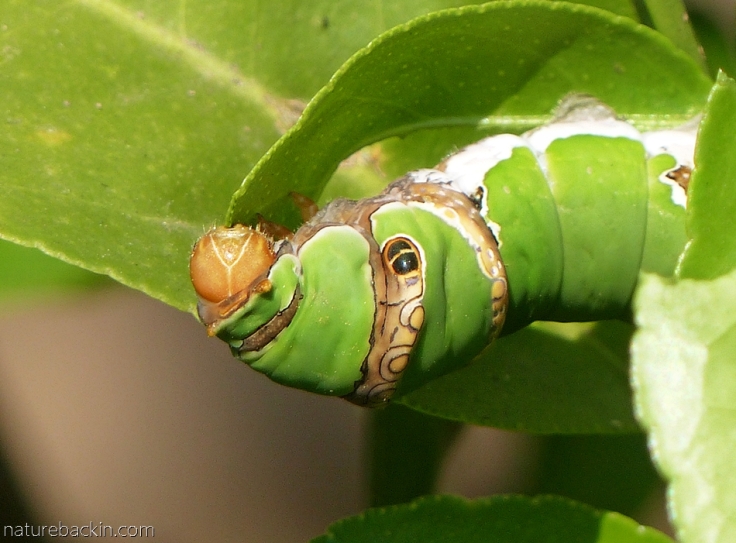
One of the few photos I took of the citrus swallowtail caterpillar (larva) in the midday sun
All caterpillars in the Papilio genus have a gland known as the osmetrium, which is situated behind the head. When a caterpillar is threatened it arches up and using blood pressure it shoots out the orange-coloured osmetrium that resembles the forked tongue of a snake, at the same time squirting a strong-smelling oily substance in an effort to repel predators.
After taking this photograph I went back to check on the caterpillar a few times and noted a southern tree agama hanging about on the shadecloth-covered fence of the veggie garden. I found that the caterpillar had retreated beneath a leaf where it appeared to be resting.
I had high hopes for the caterpillar – I thought that perhaps if I kept a regular eye on it I might even be able to see it pupate. The next time I went out to look at the caterpillar I nearly trod on the agama, which was near the base of the pot. The agama scuttled away and dropped something as it ran, but then it turned and came back, pausing as it climbed over a rock eyeing me intently before suddenly darting towards me to pick up something large and green near the base of the pot – it was the caterpillar! The agama grabbed the caterpillar and then turned its back on me as it softened the caterpillar in its jaws before swallowing it whole. Oh dear – the short life of caterpillar and the end of my study.
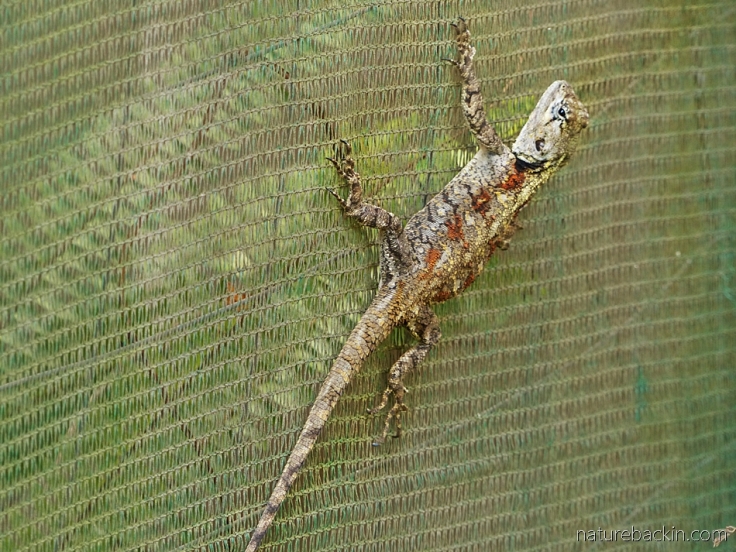
The southern tree agama glancing back at me as it climbed back up the shade cloth with its tummy bulging slightly from the bulk of the just-swallowed caterpillar
In addition to the apparent dangers of predators such as agamas, both the eggs and the pupae of citrus swallowtails can be parasitized by some species of wasps.
I did manage to take a short video of the caterpillar when I first saw it eating a leaf on the lime tree. Because it shook constantly it was difficult to get a focus. I expected to be able to return and get better photos and video – but as it turned out that was not to be on account of the caterpillar’s early demise in the jaws of the agama. But despite its iffy quality, I thought you might like to see the video anyway. The rapid movement of the caterpillar might be a bit disconcerting as it looks like I had really bad camera shake!
And so today, reading about the single egg that a citrus swallowtail butterfly lays one at a time on the leaves of its host plant, I went outside to check on the potted lime tree to see if I could see any butterfly eggs. Instead, I came across a young caterpillar in an early form (instar), black and white in colour so as to resemble a bird dropping, at least from afar – a perfect disguise.
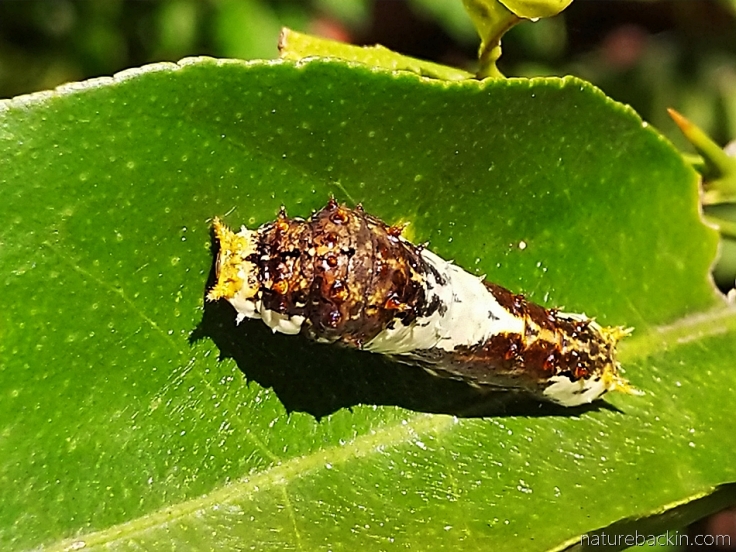
Here is the small caterpillar I saw today. It has some way to go before it reaches the full proportions and colour of a mature caterpillar. I wonder if the small projections behind the head are related to the osmetrium gland that in a mature caterpillar is pulled inside the body and only projected when the caterpillar is under threat

Earlier this week I watched a rather wary citrus swallowtail butterfly collecting nectar from crocosmia blooms. The abundant flowering of the Crocosmia aurea is a sure sign of autumn
And then later in the day, a courting couple of citrus swallowtail butterflies caught my eye. Eventually the pair of butterflies settled while mating with one of the pair holding onto a pepperdew fruit in our herb garden. They remained like that for over an hour even while a dramatic storm (that put paid to me taking any more photos) was brewing. The last time I went to see the pair of butterflies – as the sky was darkening ominously and heavy fat raindrops started falling – they had broken apart from each other with one remaining with wings spread. Hopefully it found shelter as 26 mm of rain proceeded to fall in the space of half an hour.

The mating pair of citrus swallowtails, when the sun was still bright in the early afternoon

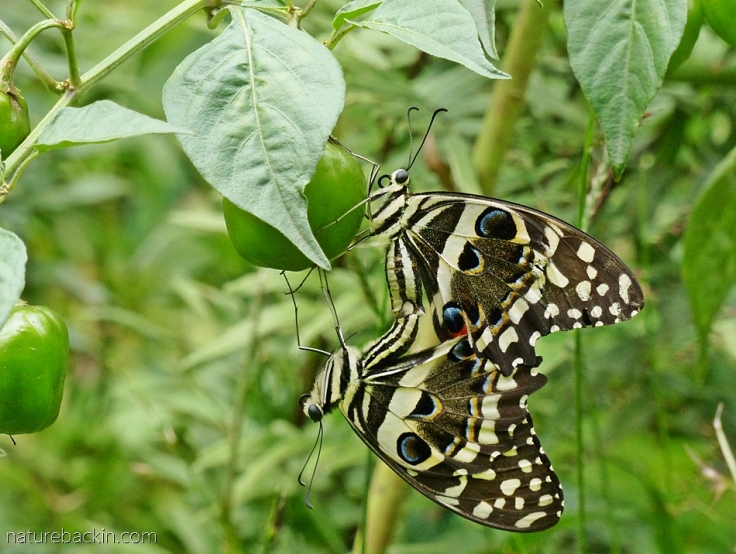
The pair of swallowtail butterflies among the pepperdews as the storm clouds gathered

A close-up of one half the mating pair as it hangs onto a pepperdew fruit. It is hard to distinguish between the male and the female although the female is generally slightly larger than the male

The other half of the mating pair. The scientific name for the order of butterflies and moths is Lepidoptera – a word that derives from the Greek lepidos (meaning scale) and pteron (meaning wing)
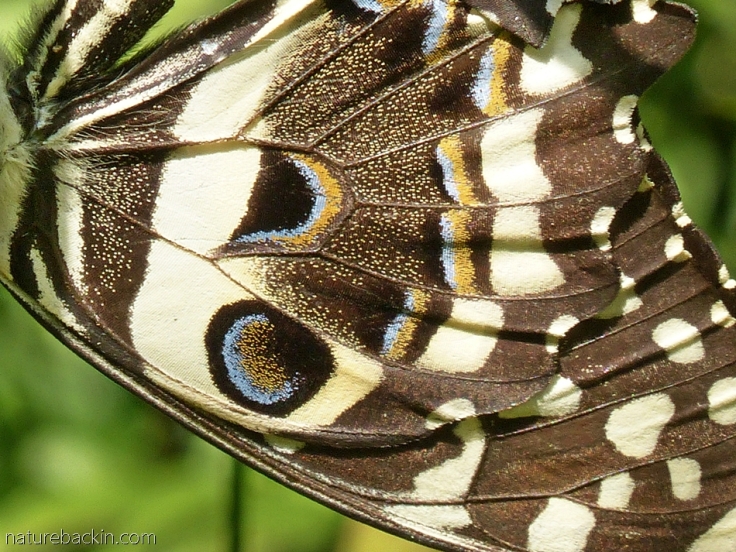
A closer-up view of a wing where the hairs on the abdomen (to the left) and the scales on the wing are slightly more visible
The wings of a butterfly are covered with tiny overlapping pigmented scales (which are flattened and modified hairs). These scales may produce colour by bending rays of light, much like tiny prisms or by pigments that are present on the scales. The hairs on the body and legs of the butterfly are not the same as hairs on a mammal. Many of the hairs have sensory nerve endings that make them sensitive to touch and vibration.
Perhaps the immature caterpillar that I found today on our potted lime tree will live to maturity and avoid falling prey to an agama or other predator, and so maybe this time I might be able to document a caterpillar’s progress.

References:
Robertson, Hamish. [n.d.] Papilio demodocus (Citrus swallowtail). Biodiversity Explorer. http://www.biodiversityexplorer.info/butterflies/papilionidae/papilio_demodocus.htm; Mackean, D G & Mackean Ian. 2004-2020. Papilio demodocus – the Citrus Swallowtail Butterfly. Resources for Biology Teaching by D G Mackean. http://www.biology-resources.com/insect-papilio-01.html; Woodhall, Steve. 2013. Butterflies of South Africa. Pocket Guide. Cape Town: Struik Nature.
Posted by Carol









October 17, 2020 at 3:45 am
I never thought I would be in the caterpillar “business” but after I noticed several brown and white caterpillars on my lime trees, I researched and discovered these beautiful butterflies. We’ve had some upsets along the way but have successfully raised 5 butterflies. Recently, all the eggs on the leaves have turned black. So disappointing. There are also a lot of aphids on the leaves which I think may have attacked my adolescent caterpillar. Is this possible? Any suggestions as to what I can spray for the aphids without harming the caterpillars? Also is it better to remove the eggs and put them in a protected enclosure?
LikeLiked by 1 person
October 17, 2020 at 1:22 pm
Hi there – how lovely to have 5 butterflies hatch. Re the aphids, they are herbivores and suck plant sap from leaves, stems and roots. If there are very many of them, it is possible they may have an adverse effect on a plant, which may have a detrimental effect on caterpillars.
The least harmful way of removing aphids is to spray them with water – from a hose or, better, from a spray bottle. It may help to brush them off at the same time (some people even squash them between finger and thumb!) The trouble with sprays, even soapy sprays, is that such sprays are also harmful to desirable critters, including insects that eat aphids and off course harmful to caterpillar eggs, and caterpillars themselves. Spraying with water about once a week can help keep aphids under reasonable control.
You may be interested to read these two pieces on controlling aphids in a caterpillar-friendly way:
Eliminate aphids! – Butterfly Fun Facts
https://butterfly-fun-facts.com/eliminate-aphids/
How to control aphids on milkweed without harming the Monarchs
https://www.rainbowgardens.biz/troubleshooting/milkweed-aphids-ladybugs-lacewings/
Re removing the eggs, I have no experience of this type of intervention so can’t help with this aspect. Planting a diversity of plants, including flowering plants and of course host plants for butterfly larvae, can help create a healthy and butterfly-friendly environment.
LikeLike
March 13, 2020 at 9:35 pm
Beautiful butterflies, they are doing what we call mud puddling something males often do to get minerals before mating.
Ark in Jo’berg successfully raised several caterpillars recently with images on his blog of the emergence.
LikeLiked by 1 person
March 17, 2020 at 8:05 pm
Ok thanks – I have read about males collecting minerals before mating. I thought the slightly decomposing grass might be providing something special.
I will check out Arks’ post on the caterpillars he raised. Thanks.
LikeLiked by 1 person
October 17, 2020 at 3:51 am
Where can I find Ark in Jo’berg’s blog?
LikeLiked by 1 person
October 17, 2020 at 1:31 pm
Here is where to find Ark’s blog
https://attaleuntold.wordpress.com/
LikeLike
March 12, 2020 at 6:40 am
I especially enjoyed both videos. I was not dizzied by either, just mesmerized. Remarkable butterflies. Thanks for teaching me about their anatomy. I did not know about their hairs. Fascinating.
LikeLiked by 1 person
March 12, 2020 at 7:16 pm
Thank you Cheryl and thanks for watching the videos. I also was interested to find that out about the hairs and scales.
LikeLike
March 11, 2020 at 6:27 am
Loved that post Carol – your photographs are stunning. Loved the tale of the poor caterpillar, pity it ended badly for him though but such are the perils of the natural world! Thank you for documenting and sharing!
LikeLiked by 1 person
March 12, 2020 at 7:15 pm
Thanks so much Carol. Indeed nothing is certain for long in the natural world.
LikeLiked by 1 person
March 8, 2020 at 9:08 am
Hello Carol,
What a treat it is to read this documentary on these beautiful butterflies!
The way you interspersed with accounts of the caterpillar made it all the more interesting and engaging. As always, your images are wonderful 🙂
Best wishes,
Takami
LikeLiked by 1 person
March 8, 2020 at 7:43 pm
Thanks very much indeed Takami. Best wishes to you too.
LikeLike
March 7, 2020 at 9:38 am
Always such a pleasure seeing your wonderful pictures and reading your articles .
LikeLiked by 1 person
March 8, 2020 at 7:29 pm
Thanks very much Edith.
LikeLike
March 7, 2020 at 9:05 am
Very interesting, all of it – the agama, the caterpillar’s feeding behaviour, and the sheer beauty of the adult swallowtails. We have one species of swallowtail in the UK but is only found in a handful of sites, mostly in Norfolk.
LikeLiked by 1 person
March 8, 2020 at 7:28 pm
Thanks Adele. I have just looked up the British swallowtail and see that it is associated with fenlands. Unlike our citrus swallowtail, I see that it actually does have a “swallowtail”. There are at least 7 species of swallowtail here in SA, with most having that decorative swallowtail,
LikeLike
March 7, 2020 at 3:10 am
Fabulous photos and you have helped clear up some confusion for me. My butterfly book lists the only swallowtail in Hawaii as ‘Papilio Xuthus, commonly known as the Citrus Swallowtail.’ But that’s surely the Asian or Chinese Swallowtail and it looks significantly different to your Citrus Swallowtail. When I see swallowtails around here, they’re in flight and I clearly don’t have the plants that encourage them to land.
Sorry that your caterpillar didn’t last long, but I guess that’s nature.
LikeLiked by 1 person
March 8, 2020 at 7:21 pm
Thanks Graham. I have just looked up the Papilio xuthus and interesting to compare with the one here.
I am checking up on the current caterpillar and it has moulted and is no longer black and white but is now the green of the mature caterpillar, just a lot smaller. Its much more overgrown in the herb patch now and so maybe this caterpillar will be a bit more protected from agamas. But as you say – that’s nature.
LikeLiked by 1 person
March 9, 2020 at 6:15 am
That’s the process I guess. Some make it, many don’t. Here, we get overrun by baby geckos, but within a couple of days most disappear, usually eaten by larger geckos. But the population isn’t dropping so it must all be working out.
LikeLiked by 1 person
March 6, 2020 at 5:26 pm
Thanks so much Carol for your informative and educative post. Never knew so much about butterflies. Too good photos.
LikeLiked by 1 person
March 6, 2020 at 8:45 pm
Thanks a lot Kamal.
LikeLike
March 7, 2020 at 7:32 am
Welcome Carol.
LikeLiked by 1 person
March 6, 2020 at 7:23 am
What a drama! Thanks for another inspiring and educational post
LikeLiked by 1 person
March 6, 2020 at 8:48 pm
Thanks Mariss. Imagine all the small dramas going on all about us, of which we are usually totally unaware!
LikeLiked by 1 person
March 6, 2020 at 6:55 am
This is a particularly captivating post. I’m astonished at the numbers of this butterfly that you seem to have, and by the richness of natural world background noise in your first video. And you have rain! Is this general in some of the arid regions you visited earlier?
LikeLiked by 1 person
March 6, 2020 at 8:44 pm
Thanks Margaret. I was surprised at the group of butterflies spending so much time at the same spot in the garden. The cicadas were quite noisy that morning and I suppose I take the bird calls somewhat for granted.
Yes we have been very fortunate with rain in our specific area – the rains were late but they have been good. Some of the arid regions remain dry and the Camdeboo region, which we visited, has had a little rain, and miraculously the rivers flowed enough for water to flow into the dry dam during mid February. The water is salty and the level very low (now at 5.3% of capacity) but it did restore some hope. A video of the remarkable sight of water flowing in right up to the dam wall can be seen here: https://www.dailymaverick.co.za/article/2020-02-11-graaff-reinet-celebrates-as-nqweba-dam-fills-up/
LikeLiked by 1 person
March 7, 2020 at 8:59 am
My word. That is an astonishing video, and rather a distressing post. The photo of the dead fish seemed to sum it up.
LikeLiked by 1 person
March 8, 2020 at 7:22 pm
The water flowing into the dam as shown in the video is amazing but as you say the situation there remains distressing, and the hardship there is ongoing.
LikeLiked by 1 person
March 6, 2020 at 2:26 am
First off, I must comment on your wonderful photographic skills again, Carol!
The Citrus Swallowtail really is one of our most beautiful butterflies and we’re lucky they’re so abundant and widespread. Your garden obviously is a favourite haunt for them.
We have a patch of ferns in a damp, cool corner of our backyard where they often visit and sleep. I don’t think there’s anything there that could serve as a foodplant for the caterpillars though and have yet to see one. It however also is a favourite hide-out for our skinks and geckos, which if they have the same propensity for caterpillar-dishes as your agama might also explain the lack of caterpillars.
I was amazed at the speed with which the caterpillar in the video kept eating while jigging the leave! Obviously this caterpillar must be a female as it is very skilled at multitasking!
As always a most enjoyable read. Have I told you how much I look forward to Friday mornings, my first cup of coffee and your latest blogpost?
LikeLiked by 1 person
March 6, 2020 at 8:28 pm
Thanks very much Dries. That is interesting that the skinks and geckos hang out where the butterflies visit and rest.
Had to smile at your multitasking comment 🙂
That is lovely to know that you look forward to my posts on Friday mornings to read with your first coffee. Makes me feel self-conscious that last week I missed my Thursday “deadline” and only got the post out during the course of Friday!
LikeLike
March 6, 2020 at 2:00 am
So very lovely and wonderful observation Carol! We were at Weenen Nature Reserve on Sunday and there were literally hundreds of butterflies, particularly Citrus Swallowtails and smaller bright yellow butterflies. On several occasions we saw hosts of them settled on fresh dung, probably drinking the moisture! xxx
LikeLiked by 1 person
March 6, 2020 at 8:22 pm
Thanks Christeen. Seeing so many butterflies at Weenen must have been wonderful. I guess there are minerals and other nutrients in the dung in addition to the moisture. We have not been to Weenen for years and we have been talking about paying a visit.
LikeLiked by 1 person
March 6, 2020 at 12:54 am
Love reading all the info you give, and your close-ups are always captivating!
LikeLiked by 1 person
March 6, 2020 at 8:19 pm
Thanks very much. It was unusual to have these butterflies sit still enough to take photos so I tried to take advantage of that!
LikeLiked by 1 person
March 6, 2020 at 12:14 am
They are beautiful – it was like watching a butterfly ballet! I hope your little instar makes it and glad to hear you’ve had more rain.
LikeLiked by 1 person
March 6, 2020 at 8:18 pm
Thanks Eliza – it is apt to describe the group as a butterfly ballet 🙂 The little instar seems not to have moved since I first saw it, but it is likely it feeds at night and then returns to the same leaf to sit tight through the day.
We have been fortunate in our local region re the rain – there are other regions that have had much less and tragically also those that have had next to nothing.
LikeLiked by 1 person
March 5, 2020 at 10:29 pm
These are fantastic! 🙂
LikeLiked by 1 person
March 6, 2020 at 8:15 pm
Thank you very much M.B.
LikeLiked by 1 person
March 5, 2020 at 10:03 pm
These are so beautiful, Carol…graceful and colorful.
LikeLiked by 1 person
March 6, 2020 at 8:15 pm
Thanks Sandy. They do have a lovely gracefulness in addition to their striking colouration.
LikeLiked by 1 person
March 5, 2020 at 10:01 pm
Some amazing photos. Well done.
LikeLiked by 1 person
March 6, 2020 at 8:13 pm
Thank you very much Nick.
LikeLike